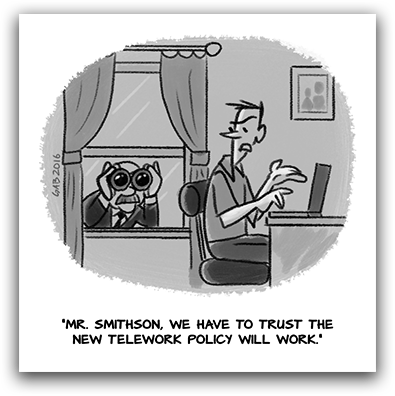The future of telework and the hybrid work environment at the Smithsonian
Secretary Bunch announces the Smithsonian’s new policies regarding telework.

It has been nearly one year since we implemented our hybrid telework approach. During that time, we closely monitored the progress of the program and gathered information from a variety of sources to inform our efforts to create an equitable, mission-focused telework approach. The Office of Human Resources has benchmarked and analyzed telework trends and best practices across the Federal government and the private sector, and we conducted a series of focus groups with Smithsonian staff and directors to get perspectives on what has been working and where there may be issues. We also have been tracking our telework trends using time and attendance data. I want to share the results of our information gathering, as well as my decision regarding the Smithsonian’s telework stance going forward, which is to have telework eligible staff on site at least two or three days per week.
Our internal telework statistics have been fairly consistent over the last nine months: the latest data show us that 43% of our workforce does not telework at all, while 25% telework less than fifty percent of their time. Five percent of our employees are fully remote, leaving 27% of our workforce who telework more than fifty percent of their time.
One of the questions that came up during this last year centered around the potential need for a minimum on-site presence. Our research has focused on this question, among others, and has revealed a wide disparity of policies and practices among Federal agencies. For example, one financial sector agency has no established minimum number of days in the office, while one cabinet agency requires a minimum of three days per week in the office. Most agencies fall somewhere between this range. There was one consistent factor in nearly all our additional research—executives, managers, and supervisors were generally required on site as much or more than their employees. The Office of Personnel Management continues to promote a hybrid workplace, with no specific on-site requirement, and their guidance does not indicate a shift back to pre-pandemic telework philosophies.
Data from the private sector also shows the lack of clear consensus on a minimum number of days in the office. Although some large companies are moving employees back to the office on a more frequent basis, that does not seem to be consistent across all industries.
This additional benchmarking reinforces the results of focus group discussions we had with staff and directors in December 2022. Those discussions yielded no consensus regarding a minimum on-site presence requirement; some participants wanted a mandated return of three or four days, citing a loss in the sense of community and professional development found in on-site work, while others asked for no mandate at all. There was, however, agreement that we should not go back to pre-pandemic practices given the many advantages to increased telework opportunities.

Based on these findings, I have decided to provide parameters within which units can operate rather than mandate a rigid Institution-wide policy that fails to consider the varying needs and work requirements of each unit. These guidelines give Directors the final say for each unit.
By June 1, 2023, I expect units to:
- Have telework eligible staff on site at least two or three days per week. However, directors have the flexibility to establish guidelines across their unit, or for specific functions, based on operational needs. You should update your telework agreements in Service Now if there are changes to your telework schedule. This expectation does not apply to staff who have been approved for Remote Work.
- Executives, managers, and supervisors are required to be on site at least the same number of days (not necessarily the same days) as their employees or affiliated staff and ensure their availability to their staff when not on site.
- Those who are responsible for onboarding new employees and engaging interns, fellows, and volunteers are required to ensure that there is always someone available, particularly when these new and affiliated staff are on-site, so that they experience a welcoming and fulfilling environment with the Smithsonian.
- Directors are being asked to ensure they are leveraging in-person work in a way that on-site workdays are productive, collaborative, and community-enhancing for individual and teams.
As we move forward, our goal is to create a hybrid work environment that leverages best practices in technology and office planning; creates a collaborative, engaging on-site work environment; and maintains a focus on productivity and outcomes regardless of location. We recognize that there is no single solution to creating a hybrid workplace and we will continue to learn as we go. If we need to adjust in the future, we will.
Finally, I want to acknowledge the large percentage of staff who are on site full-time, many of whom have roles that require an in-person presence. The Smithsonian is able to carry out its mission because of these individuals and I want to recognize their dedication.
Sincerely,
Posted: 28 March 2023
-
Categories:
Administrative News , Feature Stories , News & Announcements







